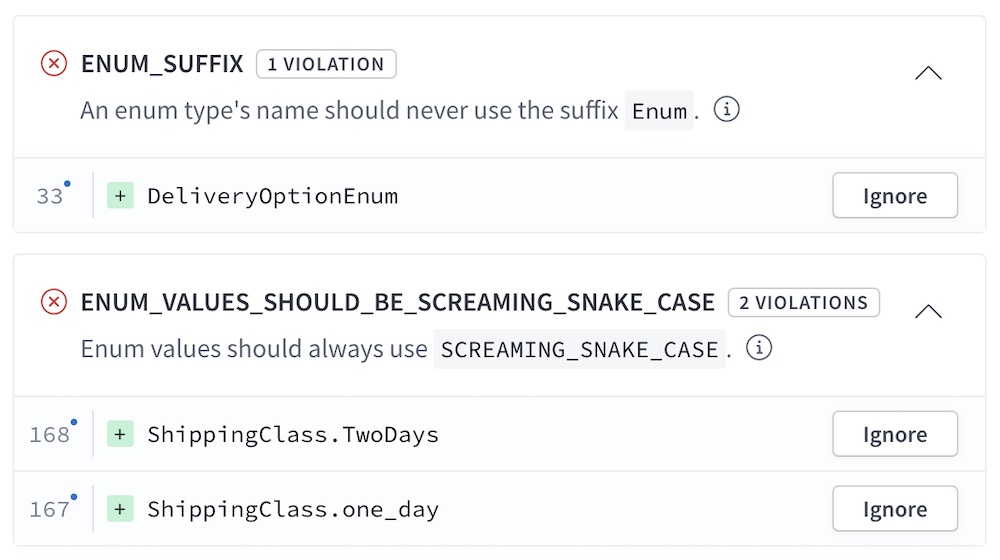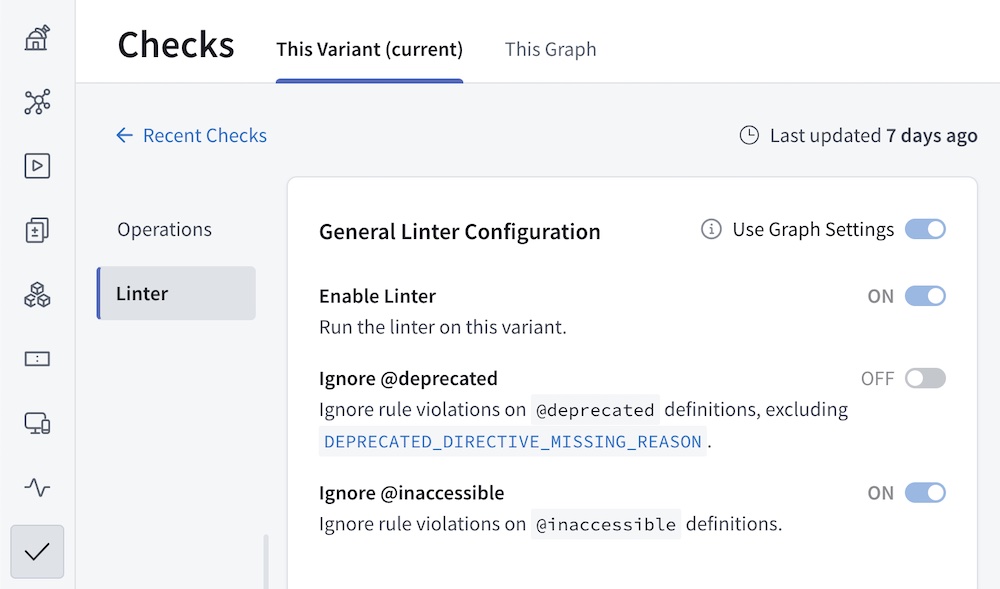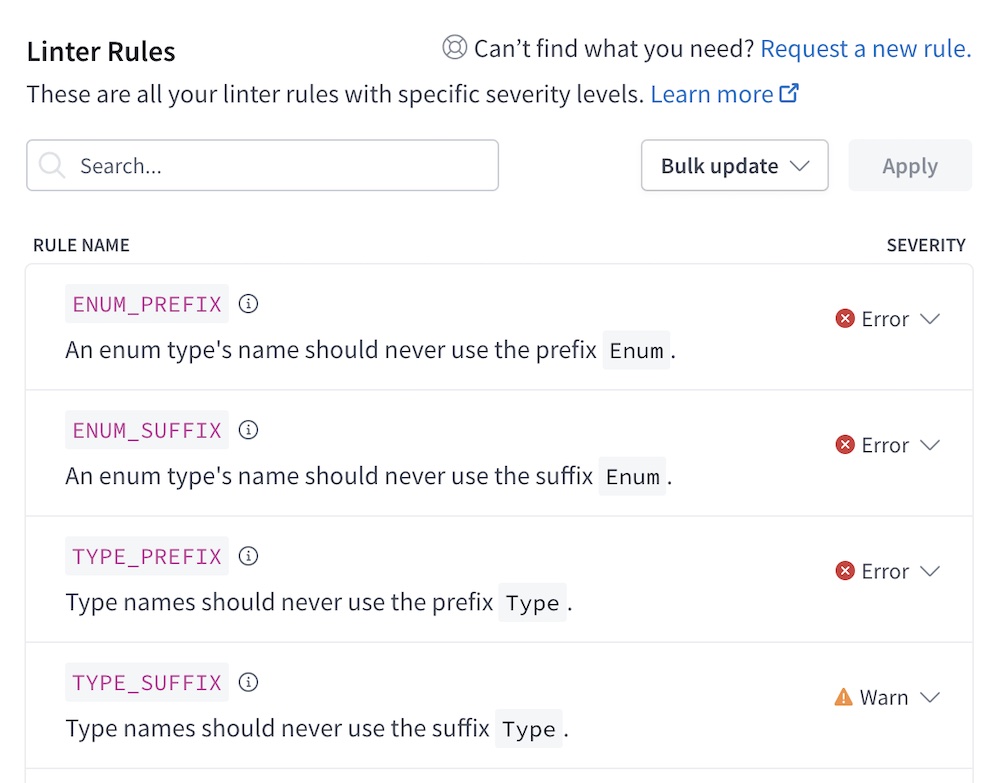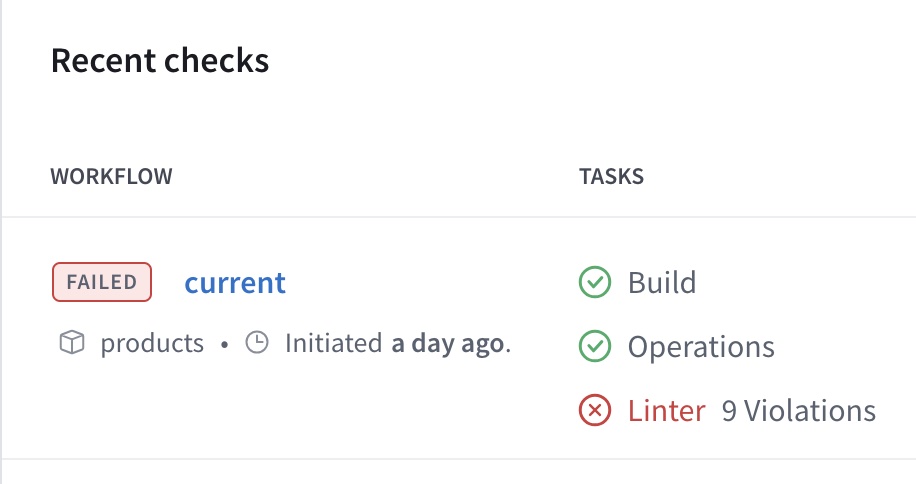Schema linting
With GraphOS
GraphOS provides schema linting to help you enforce formatting conventions and other GraphQL best practices with every proposed change to your graph's schema.

- If you set up schema checks for your graph, linting runs as a separate check type alongside build and operation checks.
- You can also perform one-off linting with the Rover CLI.
Note: Currently, GraphOS linting only analyzes parts of your modified schema that differ from your published schema. It does not flag any existing violations.
Configuring the linter
The GraphOS schema linter uses a predefined collection of rules to identify issues with proposed schema changes.
- Currently, you can define graph-wide linter defaults that apply to all variants of a particular graph.
- In a future release, you'll also be able to configure how individual variants of your graph treat violations of each linter rule.
Navigate to your linter's configuration:
In GraphOS Studio, go to your graph's Checks page.
Click Configuration in the upper right to open the checks configuration page.
From the checks configuration page, open the Linter section:

To configure graph-wide linter defaults for all of your variants, click the This Graph tab.
- In a future release, you'll be able to configure variant-specific behavior from the This Variant tab.
This page organizes linter options into the following categories:
- General Linter Configuration provides high-level options, including disabling the linter entirely.
- Approved @tag names enables you to specify approved values for the
nameargument of the@tagdirective. This directive is used most commonly with GraphOS contracts.- If you don't use the
@tagdirective, you can ignore this category. - Using a non-approved value for
nameraises theTAG_DIRECTIVE_USES_UNKNOWN_NAMEviolation.
- If you don't use the
- Linter Rules enables you to set the severity level for violations of each rule.
If you're viewing configuration for a single variant, each category displays a Use Graph Settings toggle in the upper right. If this toggle is enabled, the variant uses whatever graph-wide defaults are set for that category.
⚠️ At this time, the Use Graph Settings toggle is always enabled for all variants.
Setting severity levels
The Linter Rules category of your linter configuration displays all predefined rules and the current severity level for each:

Click a rule's severity to set it to any of the following:
- Error. Any violation of this rule causes the associated linter check to fail.
- This in turn causes the entire schema checks run to fail, which is useful for failing builds in CI.
- Warn. Violations of this rule are flagged in checks reports, but they don't cause the associated linter check to fail.
- Ignore. Violations of this rule are ignored entirely.
Running the linter
Schema linting runs automatically as part of your graph's schema checks. You can also perform one-off linting of local schema changes via the Rover CLI.
Linting via schema checks
If you set up schema checks for your graph, schema linting automatically runs as a separate check type alongside build and operation checks. You can view the results of all check types from your graph's Checks page in Studio:

For the best experience running linter checks, install v0.16 or later of the Rover CLI. Earlier versions of Rover can't correctly output the results of linter checks (but they do correctly exit with a nonzero code if a linter check fails).
One-off linting
⚠️ One-off linting requires v0.16 or later of the Rover CLI. Install the latest version.
The Rover CLI provides subgraph lint and graph lint commands for running the GraphOS linter against your local schema changes.
- Use
subgraph lintfor subgraphs in a supergraph. - Use
graph lintfor monographs (not recommended).
rover subgraph lint --name products --schema ./products-schema.graphql my-graph@my-variant
The argument my-graph@my-variant in the example above is a graph ref that specifies the ID of the graph you're comparing your schema changes against, along with which variant you're comparing against.
Command options include:
| Name | Description |
|---|---|
| Required. The path to a local Alternatively, you can provide |
| Required for |
| If provided, the linter only flags violations that are present in the diff between your local schema and your published schema. By default, one-off linting flags all violations in your local schema. |
Linter rules
See this article.